Teenage Mutant Ninja Turtles, Teenage Mutant Ninja Turtles 2: The Secret Of The Ooze, Teenage Mutant Ninja Turtles 3: Turtles In Time, TMNT (1990, 1991, 1992, 2007)
Directed by: Kevin Munroe, Michael Pressman, Steve Barron, Stuart Gillard
Written by: Kevin Munroe, Stuart Gillard, Todd W. Langen
Starring: Elias Koteas, Judith Hoag, Paige Turco, Vivian Wu
So the new Teenage Mutant Ninja Turtles film is here, and I thought I’d celebrate by watching the four previous movies, only two of which I’d seen before and that was when they first came out. They might be rubbish. What have I let myself in for? Read on!!!
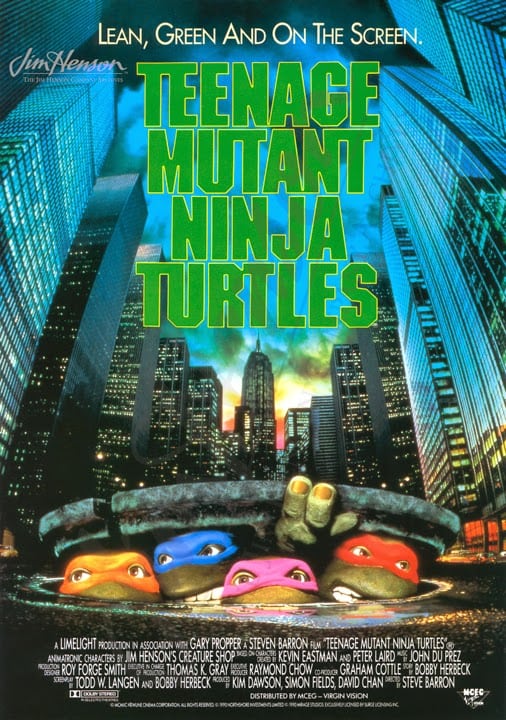
A crime wave rises in New York City amidst rumours of a gang of ninjas called the ‘Foot Gang’. Reporter April O’Neil is saved from some yobs by Raphael, one of the four Teenage Mutant Ninja Turtles who live in the sewers beneath the city. However, Shredder, leader of the Foot, is unhappy about April’s coverage and orders her to be silenced. She is attacked by the Foot but again is saved by Raphael, who had been following April to retrieve a sai he had lost in the previous battle. He carries April back to the Turtles’ hideout, and their leader Splinter then recounts to an astonished April their origins: once ordinary animals living in the sewer, they were mutated into intelligent, human-sized creatures by a discarded canister of toxic waste….

The first film in the franchise seems to be widely considered the best, and is also considered to be the darkest and most serious, though watching it again, there really isn’t much dark and serious about it! Even the complaints of the time about the film being excessively violent for a kid’s movie seem a bit silly now: sure, there’s quite a lot of martial arts fighting but it’s mostly tame and bloodless. I guess what bothered people more were that a kid’s movie had heroes that loved to fight as well as being streetwise and anti-authoritarian, but there’s much positive messaging in the film too. I didn’t expect Teenage Mutant Ninja Turtles to be a classic, but it’s an enjoyably goofy juvenile low-budget actioner which has certainly been made with care in some departments [the sewer sets, for example, are quite impressive and even provide some atmosphere in some moments] and, considering its premise, isn’t as daft as it could be. It drags a little in places, but maybe I say that because we expect these kinds of films to move much faster [which I’m sure the new film will] nowadays. It also looks and feels very 80’s despite being made in 1990.
The Turtles began life in 1984 when two young comic book artists Kevin Eastman and Peter Laird published a single-issue comic which parodied four of the most popular comics of the early 1980s: Marvel Comics’ Daredevil and New Mutants, Dave Sim’s Cerebus, and Frank Miller’s Ronin. A series soon followed, and actually a film was planned in 1985, but nobody wanted to invest in the project. Then in 1987 a cartoon series, which in the UK was called Teenage Mutant Hero Turtles because the word ninja was considered unsuitable for children, made the characters extremely popular, though the major Hollywood studios were still not too interested and the film was made independently and didn’t even find a distributor till shooting was half-done. Shot mostly in North Carolina with just a few New York shots, it basically combined elements of six comic tales, while its costumes were made by Jim Henson’s Creature Shop. Henson later said he regretted doing it because of the film’s violence. Many of Judith Hoag’s scenes as April O’ Neal were cut out or shortened, while the original ending had April and Danny go to a comic book publisher to pitch an idea of walking talking turtles! In the UK it lost five minutes due to the BBFC’s problem with nunchakus, the chain-stick weapons popularised by Bruce Lee. As a nunchaku was Michelangelo’s weapon of choice, many shots featuring the character were either removed or re-framed, while portions of two major action sequences were cut out. I must admit, one of the things I was most looking forward to was seeing the film uncut for the first time! The film went on to became the most commercially successful independent film to that date.
Opening with gloriously cheesy 80’s-style synth and guitar music in the Jan Hammer or Harold Faltermeyer fashion, though it’s actually by John Du Prez, this film sure gets into its stride immediately, though it holds back on the action for as long as possible. April is attacked by some teenage thugs and is saved by Raphael, but all we see is a black screen, while later on the second Raphael-rescues-April scene is over in a few seconds. The other major human character Casey Jones, a hockey-masked vigilante, gets a great introductory scene where he and Raphael argue over the best ways to deal with thugs and have a comical, show-offy fight. Of course the Turtles are introduced nice and early with much amusing boisterous interplay, though it took me a while to tell which turtle was which, a bit of a flaw if you’re not well-up on your Turtles! Leonardo is the leader and the most serious, Michelangelo the comedian and ‘surfer’ type, Raphael the aggressive ‘bad boy’ who often clashes with Leonardo, and Donatello the more peaceful of the four and a bit of a technological genius. When the turtles order a pizza and talk to each other like Bill and Ted, I admit, I really began to like these guys, especially Donatello’s coming up with words like ‘bossa nova’ to keep up with the surfer-style speak.
Of course around half-way through it all turns into a kiddie martial arts movie when the Turtles’ rat master Splinter is captured, and the fights are surprisingly agile and exciting, though it’s obvious that scenes like Michaelangelo and a villain each showing off with their nunchakus, a riff on a bit from Game Of Death, have been ‘enhanced’. I suppose some brutal stuff does occur: Raphael is nearly beaten to death and thrown through a window, Splinter is smacked in the face and then has his claw pushed under his chin, April is smacked in the face twice by villains, and one of the bad guys beats up a teenager [the original cut of the scene had him kill him], but it’s all done in a very restrained fashion. There’s a flashback, cheaply but rather effectively staged against black, where Splinter tells of his old master’s murder by a rival ninja named Oroku Saki. Splinter’s cage is broken and he claws and bites at Saki’s face who, bleeding and enraged, slices off part of Splinter’s ear with a katana. It sounds really vicious, but it isn’t. As I type, it’s the film’s other flashback that I can’t get out of my mind. When April has been taken to the lair of the Turtles, she’s told of their origin, and the sight of little puppet turtles growing and becoming intelligent human-like beings because of some toxic waste is bizarre and very funny!
In some ways Raphael is the hero of this film. He’s the angst-filled loner of the four Turtles, and even falls in love with April, though of course we know nothing can happen between them. Scenes between April and Casey Jones, a hockey-masked vigilante who becomes the main human ally of the Turtles, slow some of the second half of the film down and, while it’s usually fun to have a couple who initially dislike each other and bicker, and then fall in love, neither Judith Hoag nor Elias Koteas [yes, the guy who went on to be the prolific character actor] show much chemistry. More successful is the part of the story involving Danny, an alienated teenager who is amongst those taken under Shredder’s wing but has a yearning for the ‘good side’ too. Despite me being not at all a teenager, it seemed quite striking to me that this film, in its own way, really understands younger teenagers, and how they think, in a refreshingly honest and even quite brave, manner. The Foot Gang never go to school, they hang out smoking, playing video games, painting graffiti, stealing and hustling: they are cool! Of course you can’t take too seriously a film where one of the characters is a kind of cross between Yoda and Mr Miyagi in the form of a stiff rat puppet. Splinter is given some good lines, while Shredder the Darth Vader-esque main bad guy is quite menacing, though he would have been even more menacing if they’d kept in a recently revealed deleted scene where Shredder calmly sits down and has his enslaved children attack him while he’s still sitting down in order to prove his power.
John Fenner’s cinematography is rather good in the sewer sets, while the sound design throughout is surprisingly detailed yet subtle in a way that seems to becoming a thing of the past. You almost feel like you’re in the sewers, or on the streets, because you can hear every water drop, every foot step. You can even hear Raphael’s heavy breathing while he’s rescuing April. At the end of the day this may be a ridiculous film, but elements of it are done rather well, and is it any more ridiculous than your average Marvel epic? Some of the acting is weak and Steve Barron’s direction, while decent overall, is sometimes a bit clumsy during the action, while I still can’t work out what Shredder was really trying to accomplish, but, overall, I rather enjoyed Teenage Mutant Ninja Turtles. It’s no comic-book classic, but, within its limits, it’s quite a well-crafted movie really, and to me has a charm which is lacking in many of today’s superhero blockbusters.
Rating: 









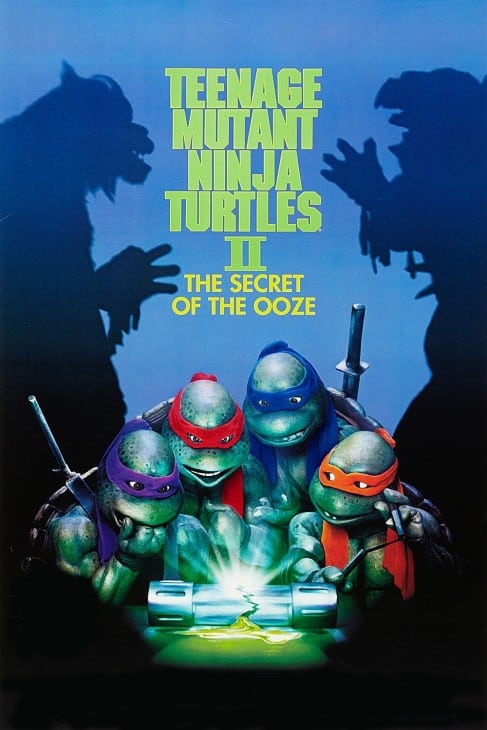
Following Shredder’s defeat, the Turtles are living with April O’Neil while they look for a new home. They come to the rescue when Keno, a pizza delivery driver, witnesses a burglary and is attacked by the robbers. Meanwhile, the Foot have relocated to a large junkyard, where Shredder’s right-hand-man, Tatsu, has taken leadership. However, Shredder is still alive, and returns to assume control. Elsewhere, a load of the toxic waste that created the Turtles is found. It has been made by Prof. Jordan Perry, who is trying to neutralize pollutants. The Turtles infiltrate his laboratory seeking answers, but discover that the Foot have kidnapped Perry and escaped with the last ooze canister, which they intend to use…..
The first film surprised me somewhat – okay, it was nowhere near being any sort of masterpiece – but it was done about as well as I reckon someone could logically expect. But this one….well, it just isn’t very good at all. Perhaps stung by the complaints about Teenage Mutant Ninja Turtles being too dark and violent for kids, Teenage Mutant Ninja Turtles 2: The Secret Of The Ooze tones all that down but doesn’t replace it with much else. It’s sometimes genuinely funny, but overall it seems like they used the bare skeleton of a screenplay rather than a completed script, while in the end they went so far with the whole ‘kid-friendly’ thing that there’s virtually no menace or tension whatsoever, and what’s the point of our heroes carrying weapons around on their person if they only get to use them in the opening scene? They may as well have not shown their weapons at all. Thinking about it, this film is pretty much what I expected the first film to be like [I barely remembered the two films though did see them many years ago] but was pleasantly surprised to be proven wrong: stupid, annoying and seemingly just rushed out with little care just to make lots of money from the parents of Turtle-obsessed kids.
In fact, the budget for this one was nearly twice that of the first: $25 million, as opposed to $13.5 million. Todd W. Langen returned to write the script [though it seems like he didn’t finish it] and Michael Pressman replaced Steven Barron as director. The studio wanted the monsters Bebop and Rocksteady from the cartoon, to appear, but Eastman and Laird were not in favour of it due to having to go though legal clearances for the characters, so Rahzar and Tokka were created. Corey Feldman declined to return to voice Donatello in the second movie, while Paige Turco replaced Judith Hoag, annoyed at much of her footage having been cut, as April. Ernie Reyes Jr., Donatello’s fight double in the first film, had the character of Keno written for him. The bigger budget allowed for the Turtles’ facial expressions to be done by animatronics built into the faces rather than being cable operated from inside the shells, while their impressive new lair was based on a decommissioned New York railway station. One stuntman broke an ankle, while another had two teeth knocked out when Leif Tilden, the guy in the Donatello suit, executed a roundhouse kick instead of a side-kick. Shot again mostly in North Carolina, the film was originally to end on a cliff hanger, with Prof. Perry being revealed to be a robotic shell for an utrom, aliens from the original comics who created the ooze to power their technology. This was dropped due to the fear of kids mistaking it for Krang, a villain of the cartoon series. The film was another big commercial success despite being disliked by many older fans of the comics. In the UK, the two brief nunchaku scenes were removed, stupid considering that in the first one, Michelangelo is actually swinging sausages about like nunchakus, not actual nunchakus themselves.
That should give you quite a good impression of what most of the action is like in Teenage Mutant Ninja Turtles 2: The Secret Of The Ooze. Unlike the first film, which gradually built up to the big set-pieces, this one goes into a big fight straight-away as our heroes rush to the rescue of young Ken, who has just caught some robbers at it. Even though this is the only scene where the Turtles use their weapons to any great degree, the whole sequence is done more for laughs rather than thrills. The comic gags and use of the shopping mall environment reminds one of Jackie Chan, and, though the choreography and stunt work isn’t anywhere near as good, it’s all quite inventive and certainly gets this sequel off to a good start, even if it also tells you that it’s going to aimed far more at little kiddies. Unfortunately, as the film progresses, it becomes apparent that it’s not as fun a movie as it should be. At the end of the day, there’s nothing inherently wrong with a silly children’s film if it’s done well and has enough to keep the adults amused, but this one just starts to grate once the so-called script begins to refuse to do anything good with the ideas it does have, while some of the best aspects of the first film are just not repeated, a good example being the Turtles themselves. In the first movie, while I had trouble telling them apart in a few places, their characters were still well defined and their interplay very enjoyable. Here, they just seem to meld into one, so when they do converse it’s mostly just like watching four versions of one Turtle talking to each other.
As before, it all boils down to a load of fight sequences as the Turtles battle the bad guys for the substance from which they were created, then have to fight Rahzar and Tokka, two monsters made by Shredder giving the Ooze to a wolf and a mock-turtle respectively. The costumed creatures just look ridiculous and inspire no fear whatsoever though their first scene is rather hilarious with the monsters rushing to Shredder thinking he’s their mother. “What did you expect? They’d come out quoting “Macbeth”?”, says Professor Perry. Perry is played by David Warner, and he camps it up nicely, obviously deciding to make the most of it and just have fun. It all ends up in a club, conveniently next to the lair of the Turtles, where Vanilla Ice is playing. The climax is really quite cringe-worthy as the man [I’m no expert on, nor a big fan of, rap, but the nonsense he spouts in this film makes M.C.Hammer’s efforts in the previous film seem really very good] makes up ‘The Ninja Rap’ on the spot while the Turtles are battling their opponents and everyone, including poor old Warner, ends up dancing. By the time Shredder turns into…Super Shredder, the action has become so tame that the opponents barely exchange blows, though this isn’t as disappointing as Shredder sending Rahzar and Tokka to wreck havoc, but all they do is knock over a lamp post.
Parts of the story just make no sense and obviously haven’t been thought through, such as why did the company TGRI keep hundreds of canisters for fifteen years and then decide to dispose of them? Splinter gets into the action a bit more, but April has little to do, while Casey Jones is totally AWOL. His replacement for this film is Ken, and Ernie Reyes Jr. does get to bust out some cool martial arts moves which are more impressive than anything the Turtles do. As for Shredder, he’s still allowed to be a bit menacing, though his end is extremely lame, and if he can survive falling into a dumper truck then it’s doubtful that a small falling bridge will do the trick either. At least April is played by an actress who is both prettier and a slightly better actress than the one before. It’s also reassuring that, though they’re barely characterised individually, the Turtles are still immature teenagers who love to fight and constantly eat pizza instead of something more healthy, which is why some still felt the need to criticise the film for being a bad influence on kids when it came out. I remember very well some survey which claimed it could trace the majority of aggressive, anti-social classroom behaviour to the Ninja Turtles, though set against that is the very positive message that you don’t need to be popular to be successful and make a difference. The Turtles mostly remain underground because they are, in the end, monsters, and are hardly known by the general population, but still manage to achieve great things.
Though this is a somewhat brighter-looking film than the first one, Pressman fails to bring much style and even pace to the proceedings despite the large amount of action. Composer John Du Prez again supplies a pleasant score with an enjoyable Beverley Hills Cop-style main theme, and there is still something oddly likeable about the whole enterprise. There was never a moment, even when Vanilla Ice appeared, where I wanted to switch the darn thing off, and I suppose if you think of it as a film just aimed at kids then it gets by. If I was a ten year old boy I’d probably love it, though doesn’t necessarily mean that it would be good for me. Teenage Mutant Ninja Turtles 2: The Secret Of The Ooze is sometimes amusing, but is generally a lazy sequel that certainly didn’t leave me with distinct fondness for the Ninja Turtles like the first film did!
Rating: 









Japan 1603: four samurai chase and kidnap young Prince Kenshin. In the present, April O’Neal gives the Turtles and Splinter gifts, the latter an ancient Japanese sceptre. Meanwhile back in 1603 Kenshin is scolded by his father, Lord Norinaga, for disgracing their family name, but Kenshin argues that his father’s desire for war is the true disgrace. In a temple, brooding Kenshin finds the same sceptre and reads the inscription: “Open Wide the Gates of Time”. April is sent back in time while Kenshin is sent to the present, each wearing each other’s clothes. April is imprisoned, and the Turtles, using the sceptre, set out to go back in time to save her, but they have to do it within 60 hours, otherwise the sceptre’s power will disappear due to the space-time continuum being out of sync…..
This seems to be generally regarded as the worst Turtle film, and it wasn’t much of a box office success either, it coming out when the Turtle craze had passed. I only saw it for the first time the other day. Actually, it’s a bit of an improvement on the second film. Though it didn’t happen in any of the comics [in fact it doesn’t use much from the comics at all], something which seems to offend fans, I rather like the idea of placing the heroes in a half-shell in Medieval Japan, though part of that could be my fondness for time travel stories, and the story ends up both not being developed as interestingly as it could and not making much sense. It does make for a reasonably fun, light, inoffensive action adventure, though it’s all aimed primarily at kids without much to entertain the adults and also suffers from looking very cheap, particularly the Turtle costumes whose poor quality kept taking me out of the film. It all seems as if they came up with a few good ideas and then just muddled through without much thought or care, though it does conclude in a surprisingly downbeat, poignant fashion which stuck in the mind.
Indeed the budget was lower for this instalment, and it meant that they didn’t hire Jim Henson’s Creature Shop to do the costumes. This film had a new scriptwriter, Stuart Gillard, and he was also chosen to direct. The only member of the cast to return from Teenage Mutant Ninja Turtles II: The Secret of the Ooze was Mark Caso , the performer inside the Leonardo costume, though Corey Feldman, who appeared in Teenage Mutant Ninja Turtles, made his return as the voice of Donatello. This one was filmed mainly in Oregon, which certainly didn’t double well for Medieval Japan! Again, it suffered BBFC cuts to remove nunchakus, though only a few seconds. The film was not very successful, nixing plans for Teenage Mutant Ninja Turtles: The Next Mutation, which would have been about the Ooze from the second film causing Splinter and the Turtles to mutate further. Michelangelo would have looked more human allowing him to walk amongst the people of the City, Donatello would have had psychic abilities, Raphael’s rage would cause him to mutate into a fearsome creature with claws and spikes jutting from his body, Leonardo would have the ability to mutate his skin into different textures, and Splinter would transform into a creature twice his size that he would have limited control over. This all sounds great fun, but sadly never came into fruition, though the concept of having the Turtles mutate into creatures was later used in the ‘New Mutation’ saga of the cartoon series.
The early portion of the film cuts between Medieval Japan and modern-day New York in a somewhat disjointed fashion, while the Turtles are introduced not fighting but doing a silly dance, though you have to remember these are still teenagers. A few scenes later Michelangelo is given an old lamp and he wears the lampshade and amusingly impersonates Elvis Presley in Blue Hawaii. When the Turtles are spirited to 1603 to save April, four Japanese soldiers are in turn spirited to 1993 in their underwear. They have trouble adjusting. Casey Jones makes a welcome return in this film, but he spends most of his time separate from the Turtles with the four soldiers. At one point, he tries to teach them hockey and they beat each other up. This, and a scene where April’s personal stereo starts playing and the annoyed Japanese, who think she might be a witch, smash it causing her to say: “If you’d asked me, I would have turned it off”, sums up the level of the film’s humour. Very kid-friendly stuff that causes a chuckle but not much more, as if not much effort was really made. Elias Koteas, playing Casey, also shows up in the ‘past’ section as a baddie, and I couldn’t for the life of me work out if he was supposed to be Casey or not, as if the explanatory parts of the script had been cut out. In any case, as soon as the Turtles are in Jaan we get two fight scenes, with some choreography that is often better than we saw in Teenage Mutant Ninja Turtles II: The Secret of the Ooze and even a bit of half-decent swordplay, though of course it’s still very toned down and those BBFC-pestering nunchakus aren’t used at all this time round except for some shots at the beginning of Michaelangelo practising with them and hitting a punching ball.
The excitement of the ‘saving a kingdom’ plot is minimised by the kid’s TV look and feel of the piece, and we seem to get a build-up to the villains using cannons on the Turtles only it doesn’t actually happen, but what are so annoying about this film are the costumes. The new Splinter, voiced by a new actor whose voice is far too light, looks absurdly stiff and his eyes don’t even move for much of the time, while the simplified Turtle suits look so poor that some of the time you can actually see where the masks end and the body suits begin, thereby magically creating the illusion that these are guys in turtle costumes. For God’s sake the animatronics used to operate the mouths of the turtles completely fail to synchronise with what’s being said. It doesn’t even look like they made much attempt to have them resemble the costumes in the previous two movies. At least the personalities of the Turtles are more distinct this time round, though aggressive rebel Raphael isn’t really much of an aggressive rebel at all. The Turtles don’t even seem to enjoy fighting much. “Fighting’s for grown-ups, and only if they’ve got no other choice”, somebody says at one point. They’ve really softened the Turtles in this movie, even more so than in the second film, and in doing so they’ve removed some of their uniqueness.
The lovely Vivian Wu shows up in this film and this time round it’s Michelangelo who falls for a human, but it’s towards the end where this movie actually becomes a little emotional and, should I say, deep, as if they realised this would be the last Turtle film for some time. Two of the Turtles are reluctant to return to New York, where they may be heroes but are also sewer dwellers whom many may not even give any notice too or even dignify them as such. There is a sense that they’re tired of being what they are and living the lives they live, but in the end just can’t move on and are stuck having to do what they do. It’s all a little sad, not just because I felt sorry for the Turtles, but also because some thought had been applied here and if the same level of thought had been applied to other aspects of the film we could have had a movie that was actually rather good. In the end it’s still a very average children’s film that at times seems written by one, and after a while I realised that what I was enjoying most was the Turtles themselves, and got to wondering why they weren’t in a more worthy film.
Paige Turco, though burdened with a new hair style that makes her look considerably older than she is, makes a welcome return as April. The direction is reasonable. The Japanese setting allows composer John DuPrez to write the most flavourful score of the trilogy. In fact, it probably belongs in a better movie. There is some pleasure to be had from Teenage Mutant Ninja Turtles 3: Turtles In Time. It’s hard to really dislike a film when a Turtle makes a pizza in Medieval Japan but accidently burns it and uses it as a Frisbee instead. However, it drops the ball far more than it should, and could have done so much more with, for example, the culture clash themes. It’s mostly infuriating because it had some real potential and could have been so much better than it is. I suppose I kind of enjoyed it though, because I’d read that it was a really bad film, and it isn’t really. But then again, maybe I’m becoming a bit of a fan.
Rating: 









3000 years ago, an Aztec warlord named Yaotl and his four generals discovered a portal opening into a parallel universe. It made him immortal, but turned his generals into stone and released 13 immortal monsters that destroyed his army as well as his enemies. In the present day, April is in Central America. A group of corrupt officers steal a village’s supplies but are subdued by Leonardo, who is there trying to ‘find himself’ and doesn’t want to return to New York, where the other Turtles have grown apart. Donatello is an IT specialist, Michelangelo a kid’s birthday party entertainer, and Raphael works at night as a vigilante. April operates a company that locates and acquires relics for collectors, and returns to New York with a statue for her client, Max Winters, but Max is actually the immortal Yaotl, and he’s hired the Foot Clan to search the city for the thirteen beasts before the portal opens again….
This CGI animated movie, which follows on from the third film, is a considerable step up from the second and third Turtle films. It’s still basically aimed at kids, which means that some things have been toned down or even dumbed down, but not to the extent of Teenage Mutant Ninja Turtles 2: The Secret Of The Ooze and Teenage Mutant Ninja Turtles 3: Turtles In Time, and it remains a solid animated actioner that attempts a decent plot [something it doesn’t entirely succeed in due possibly to heavy cutting] and even some characterisation and emotional depth. While you wouldn’t expect Pixar-level animating, it also looks fairly good for what was quite a moderately budgeted animated film compared to many others, and while I was watching it I wondered if the Turtles can only really be successfully realised via animation, and that hopefully a really great animated Turtles film may be made one day, but TMNT is certainly several giant steps in the right direction.
A CGI Turtle film was first announced in 2000, with would-you-believe it John Woo supposedly at the helm, and then again in 2004. By then Golden Harvest’s rights to the franchise had expired, but Warner Bros, soon took charge and production on a new film got under away written and directed by Kevin Munroe. His first concept was the Turtles in space, and he also considered the ideas of Raphael dying and revived by Max’s technology, but Turtle co-creator Peter Laird, who was heavily involved with the project, objected to the latter. The animation was done by Imagi Entertainment in Hong Kong and was dubbed by a mostly, though not entirely, new cast to the series. Mako was announced as the voice of Splinter the day before he died, and Greg Baldwin did some of his lines. The DVD has an alternate opening and closing, plus deleted scenes involving training, April and Casey, and an extended intro. for Michaelangelo, though it seems to me that quite a bit more was cut out because there’s an uneven emphasis in the film as it stands. TMNT was a sizeable hit, which makes me wonder why a sequel wasn’t put into production. Despite Munroe talking of ideas of potential follow-up, from bringing back Shredder to going back to Aztec times to going to the planet of the Triceratons, aliens resembling anthropomorphic triceratops, it never happened.
There’s a Lord Of The Rings-style [though actually it reminded me more of the one in The Mummy Returns] big battle prologue which sets up the main story with economy, then we see our heroes running and leaping across the tops of buildings Spiderman-fashion. Leonardo gets in a brief bit of action very early in Central America [couldn’t they have just said Mexico, which is where the Aztecs lived?], but it happens mostly off-screen, and the Turtles aren’t really the Turtles we are used to. Continuing some of the ideas set up towards the end of part three, the Turtles are not the unit they once were and two of them don’t even fight crime but have ‘proper’ jobs, while Raphael is a vigilante nicknamed Nightwatcher and Leonardo is on a kind of extended holiday of soul-searching. This is all quite interesting, and when Leonardo reluctantly returns, tries to become a leader again and it becomes largely about his conflict with Raphael, I almost wished that this had become the emphasis of the whole film and not so much about immortal baddies, monsters loose in the city and the return of the dreaded Foot Clan.
The stuff involving the baddies is a bit convoluted for a film like this, and why do we need to have April later repeat what the prologue tells us? While the first big action scene involves the Turtles aiding the Foot Clan in battling a Yeti-like monster, the use of a montage showing the Foot Clan rounding up and capturing the monsters hardly makes these monsters seem like a powerful menace. With two villains who end up being somewhat ‘good’, the story doesn’t entirely make sense and creates a few disappointments. Near the end, April goes into action as a ninja, but we don’t get the expected fight with deadly female ninja Karai, and the film still slightly minimises the martial arts aspect. We do get to see Leonardo and Raphael finally give in to their years of built-up antagonism and go at it in pouring rain, and there’s one spectacular bit where we pan over lots of combatants near the end and we can see the Turtles doing lots of amazing stuff including walking on the heads of Foot soldiers, but most of the fighting tends to have them battling monsters, and we don’t see Michelangelo’s nunchakus at all except for one brief glimpse where he’s swarmed by kids at a party he’s performing at, a strange choice considering the BBFC had changed their policy regarding them. Still, the action, and the last half an hour is pretty much all action, is very fluid and easy to make out.
There’s no mistaking the Turtles for each other in this one, characterisation being especially well done, but there’s so much emphasis on the rivalry of Leonardo and Raphael that the other two get short shrift, some of their scenes maybe having been cut. Raphael even gets the most exhilirating moment of the film when he skateboards down a sewer. Casey and April, who seem to share a house, have a decent amount of stuff to do though Casey comes across as too thoughtful and ‘nice’ for his character. Then again, characters do change. Visually TMNT looks a little drab though that’s obviously the effect they were going for, while the animation is certainly smooth and there’s lots of lengthy, even ‘show-offy’ computer pans. The format also really allows us to see the Turtles’ dexterity in a way live action couldn’t depict. The Turtles look great except for the fact that they seem to have lips rather than beaks, and it’s good to see Splinter not just look more like a rat but wearing a karate outfit rather than rags. There’s also some nice references to earlier films such as another face-off between Casey and Raphael, only this time Raphael is the aggressive one, and lots of ‘props’ being shown near the end, plus there’s just the right amount of humour, mostly through moments of characterisation and lines, though there’s a great comical fight in a kitchen between Raphael and a small monster, the funniest bit being where a fridge falls on top of the monster, the music cuts out and the monster is heard making a whimpering noise. This was actually a mistake in the soundtrack, but when the filmmakers saw it, they couldn’t stop laughing and left it in the film. All the monsters, inspired somewhat by mythical beasts, are well designed.
The voice cast, which include Patrick Stewart [Yaotl, Sarah Michael Gellar [April] and Zhang Ziyi [Kasai] all seem to be enjoying themselves. Klaus Badelt’s score is firmly in the Remote Control fashion and is therefore a bit colourless but it backs up the action reasonably enough. Just when I thought I was never going to see a half-decent Turtle film again [word seems to be that the new film is lousy, but this could be wrong], TMNT, for me, came some way to restoring their image, even if it has some glaring plot, structural and editorial flaws. In fact, I think it’s the best of the lot so far. What a shame that there weren’t any sequels.
Rating: 









Review of the new film coming soon!



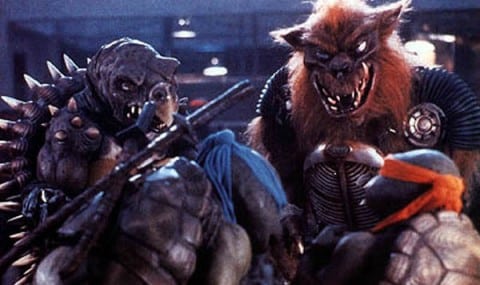
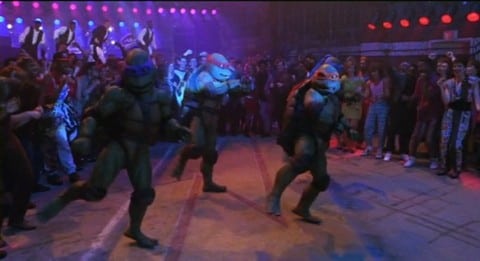

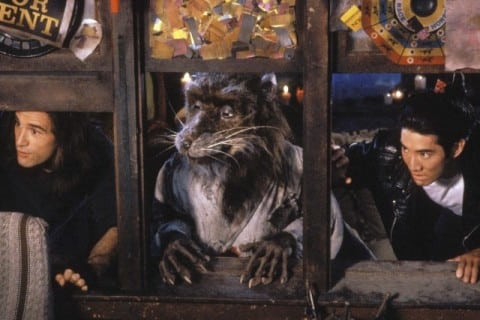
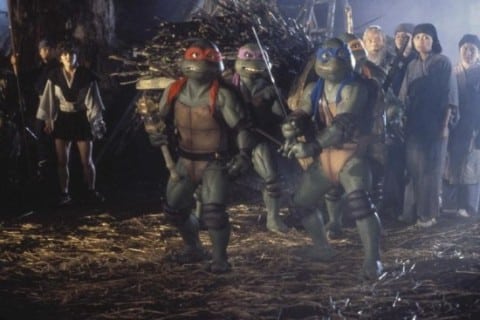

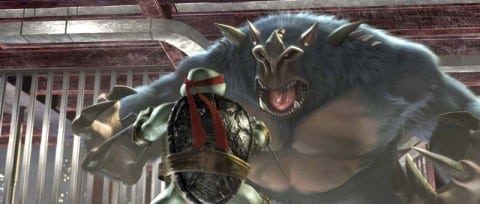


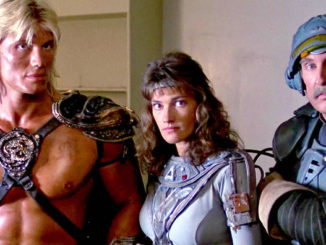


Be the first to comment